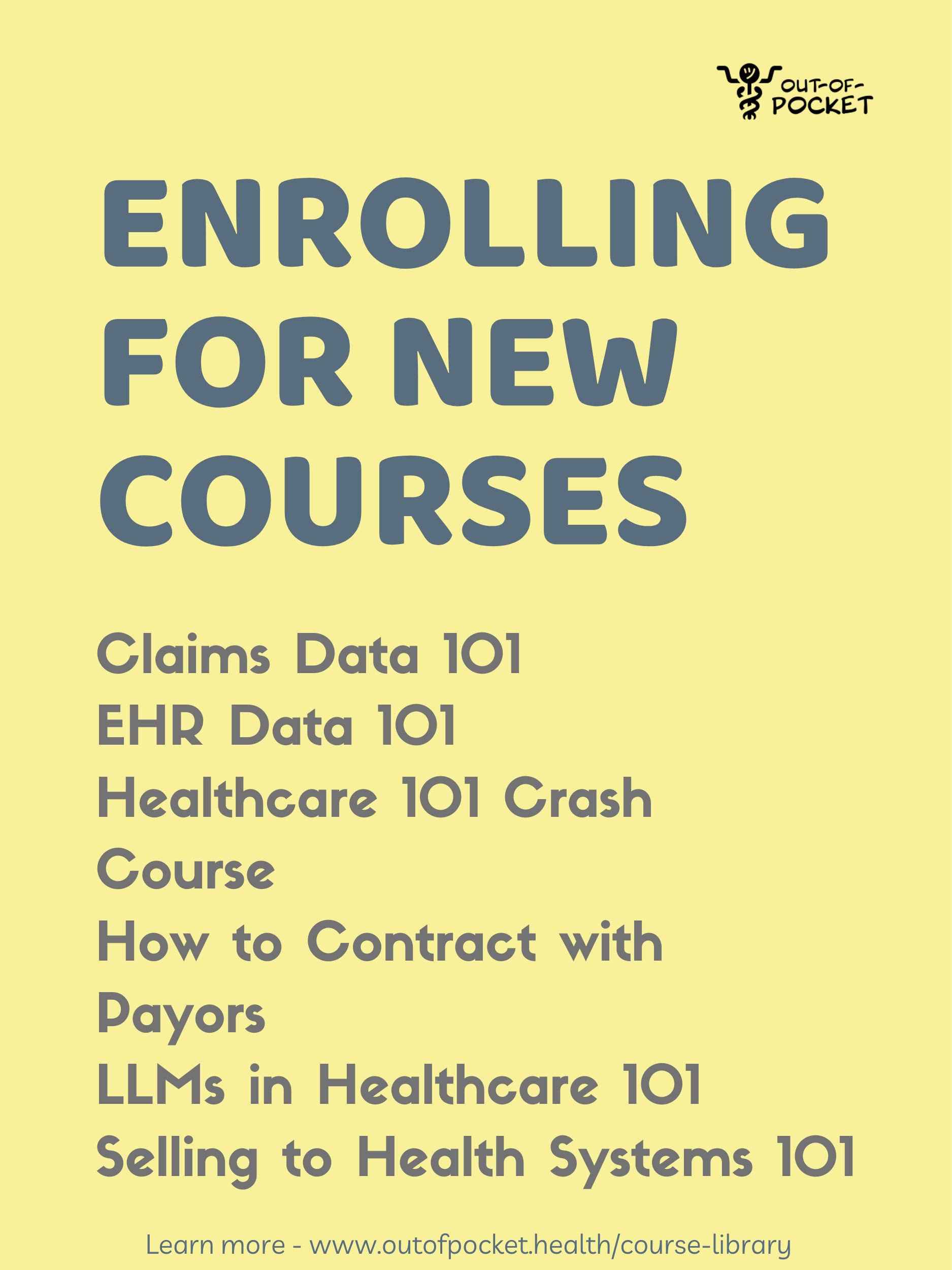Can AI solve the pain of endless hold times?
Get Out-Of-Pocket in your email
Looking to hire the best talent in healthcare? Check out the OOP Talent Collective - where vetted candidates are looking for their next gig. Learn more here or check it out yourself.
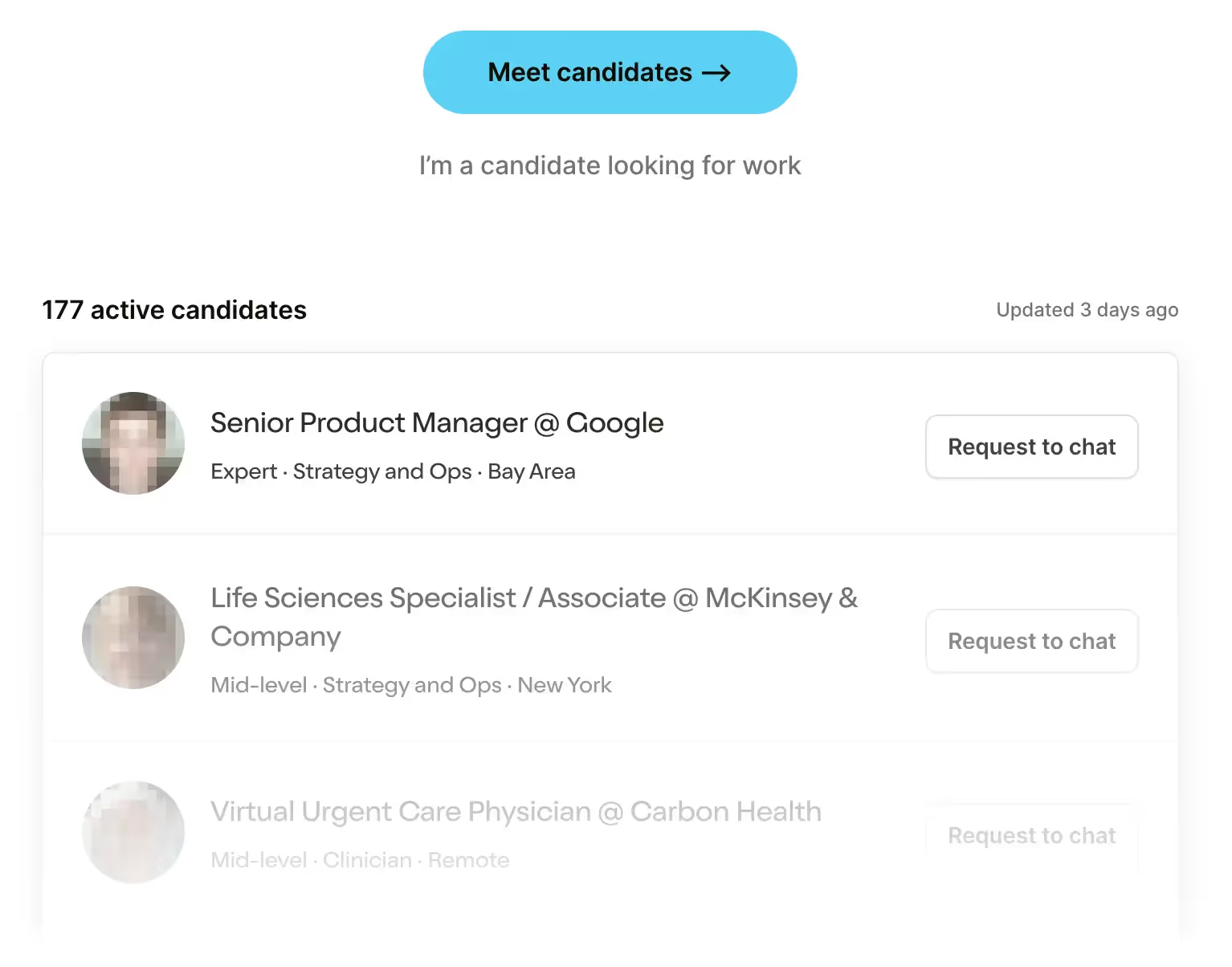 Hire from the Out-Of-Pocket talent collective
Hire from the Out-Of-Pocket talent collectiveHealthcare 101 Crash Course
%20(1).gif)
Featured Jobs
Finance Associate - Spark Advisors
- Spark Advisors helps seniors enroll in Medicare and understand their benefits by monitoring coverage, figuring out the right benefits, and deal with insurance issues. They're hiring a finance associate.
- firsthand is building technology and services to dramatically change the lives of those with serious mental illness who have fallen through the gaps in the safety net. They are hiring a data engineer to build first of its kind infrastructure to empower their peer-led care team.
- J2 Health brings together best in class data and purpose built software to enable healthcare organizations to optimize provider network performance. They're hiring a data scientist.
Looking for a job in health tech? Check out the other awesome healthcare jobs on the job board + give your preferences to get alerted to new postings.
TL;DR
Phone calls are one of the main ways patients interact with providers. The most common call you’ll make is scheduling an appointment. We go through some of the components that make appointment scheduling so hard, and why it gets done over the phone.
Assort Health is using AI agents (voice, text, email, web) to make it easier for patients to interface with providers. Their goal is to use agentic AI to give practices the ability to handle most interactions with patients, with the hardest workflow typically being scheduling appointments.
We talk about their ROI pitch, the new capabilities their product gives practices, and go under the hood. We also talk about what kinds of competition they might face and issues with scaling the product as it grows.
If you tell them OOP sent you, they’ll give you $5,000 in credits. Don’t tell me I haven’t done anything for you all.

—
This is a sponsored post - you can read more about my rules/thoughts on sponsored posts here. If you’re interested in having a sponsored post done, let us know here.
Company Name - Assort Health
Assort Health uses AI and agent automations for patient interaction, but they’re most known for handling scheduling appointments (and all the weird edge cases that come with that).
Assort is short for “ass or telephone,” which are the only two ways you can schedule a doctor’s appointment today. And no I don’t care that it doesn’t make sense.
Today we’ll be focusing on one of the most common workflow requests they get, scheduling.
Why is scheduling difficult?
Let’s first talk about why scheduling an appointment with a doctor is so difficult. Every time I call, the next appointment is either in 20 minutes or 3.5 months and there’s nothing in-between. Similar to scheduling with my friends with kids.
There’s a few components to appointment scheduling:
First, you need to match what patients are coming in for with what the office is able to support. Patients want to come in for all sorts of reasons, and each one:
- Requires different amounts of time, which can also change depending on what you discover during the appointment and if they answer “how’s it going?” literally.
- Has a different level of urgency. Is this something that needs to get in ASAP or not?
- Requires docs who are in the right specialty to see them and take their insurance.
- Might require certain types of equipment and rooms within the clinic (e.g. a procedure), and those might have their own support staff.
You then also need to match that against the individual docs preferences. Some might not want to see new patients in the mornings, or want to reserve specific times for procedures. Their schedules can also vary for things in their personal lives, like they’re sick or working around their kids schedules. Or just golf.
Then you need to layer the insurance complexity on top of this. Is the patient’s insurance valid? For the patient coming in, will their insurance require a referral for the visit to be covered?Does the insurance require pre-approval before that procedure can be done? Some steps need to be done in advance for certain patients before scheduling, otherwise the doctor won’t get paid.
And then there’s a ton of miscellaneous things layered on top. What about patients who don’t show up? Or patients who want to pack a bunch of problems into one 15 minute visit and it goes over? Or a patient has an urgent issue and needs to be squeezed in the same-day? Or when a patient schedules an ultrasound at an OB-Gyn AND follow-up appointment with that OB afterwards - there’s logic that two appointments need to be scheduled, with 2 different and specific providers, in a specific order.
Scheduling doesn’t seem so easy now, does it?
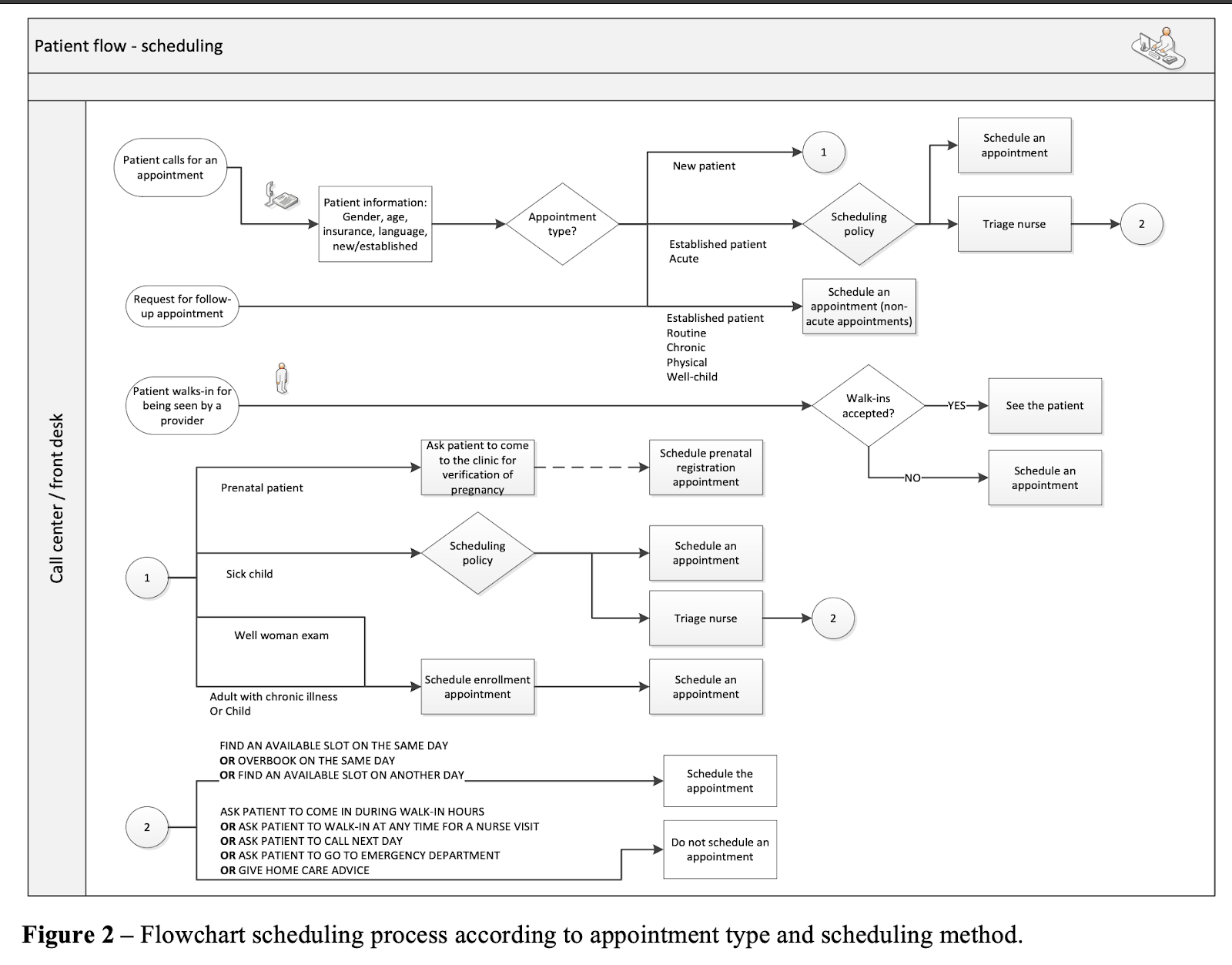
What is the pain point?
A lot of the information that needs to be captured above can’t fit neatly into static forms with rigid decision trees. It requires getting info from insurance companies, sussing information out of patients, and having the local knowledge of your practice operations in real-time encoded on post-its next to a keyboard. Rather than a decision tree, it’s more like a knowledge graph.
Because of this, a ton of scheduling actions happen via phone calls. Phone calls are flexible in the type of information you can get - they’re unencumbered by the constraints of forms, data standards or APIs. Plus it’s easy to ask follow-up questions to get more info.
But because scheduling gets managed via phone calls, a few things happen.
- As a patient, you frequently have to call to make or change appointments. This means it has to be done during work hours + you’re frequently put on long holds. I didn’t even know a phone call could trigger a fight or flight reaction until I had to call the front desk of a doctor’s office.
- For providers, they end up hiring full time staff or call centers just to handle appointments. High turnover means needing to retrain staff on a lot of esoteric rules of the practice, billing, regular patients, etc.
- There’s a ton of lost revenue that happens in the form of patients not showing up, or net new patients hanging up before getting scheduled.
There’s a lot of lost opportunity. Can you use those phone calls to triage patients or better understand the patients preferences by capturing data during the call? Can you proactively reach out to patients if an appointment opens up? The phone call to the practice is one of the patient's first touch points with a provider - and right now it seems like a missed opportunity not to do more.

What Does Assort Do?
Assort Health deploys patient-facing AI agents trained on different specialty workflows. They help practices with patient-facing needs - things like lab responses, med refill requests, triaging to the right doctor, billing questions, scheduling appointments. Their product has a few different parts:
- An AI agent that can take inbound or outbound calls from patients. It asks patient intake questions, reasons for appointments, triages to the right provider, and can schedule/reschedule patients. If patients prefer text, they can do it via a form that’s sent.
- If patients need to be escalated, the voice agent creates a warm handoff to a person.
- There are AI copilots for practice managers and call centers so they get the patient context from the call + navigate the EHR + get assistance based on the practice rules to figure out next steps.
- The AI agents have “memory” that can then build a profile about the patients, their communication preferences, etc. So remember that I say “please”, T-800.
- There are dashboards for practices to ignore showing how many patients were scheduled, where they dropped off, reasons for being dropped off, etc.
- Assort does outbound including pinging people who are due for specific screenings or re-activating patients that haven’t been seen in a while via campaigns of SMS, email, phone call.
You can check out a demo on their website to see how it works.
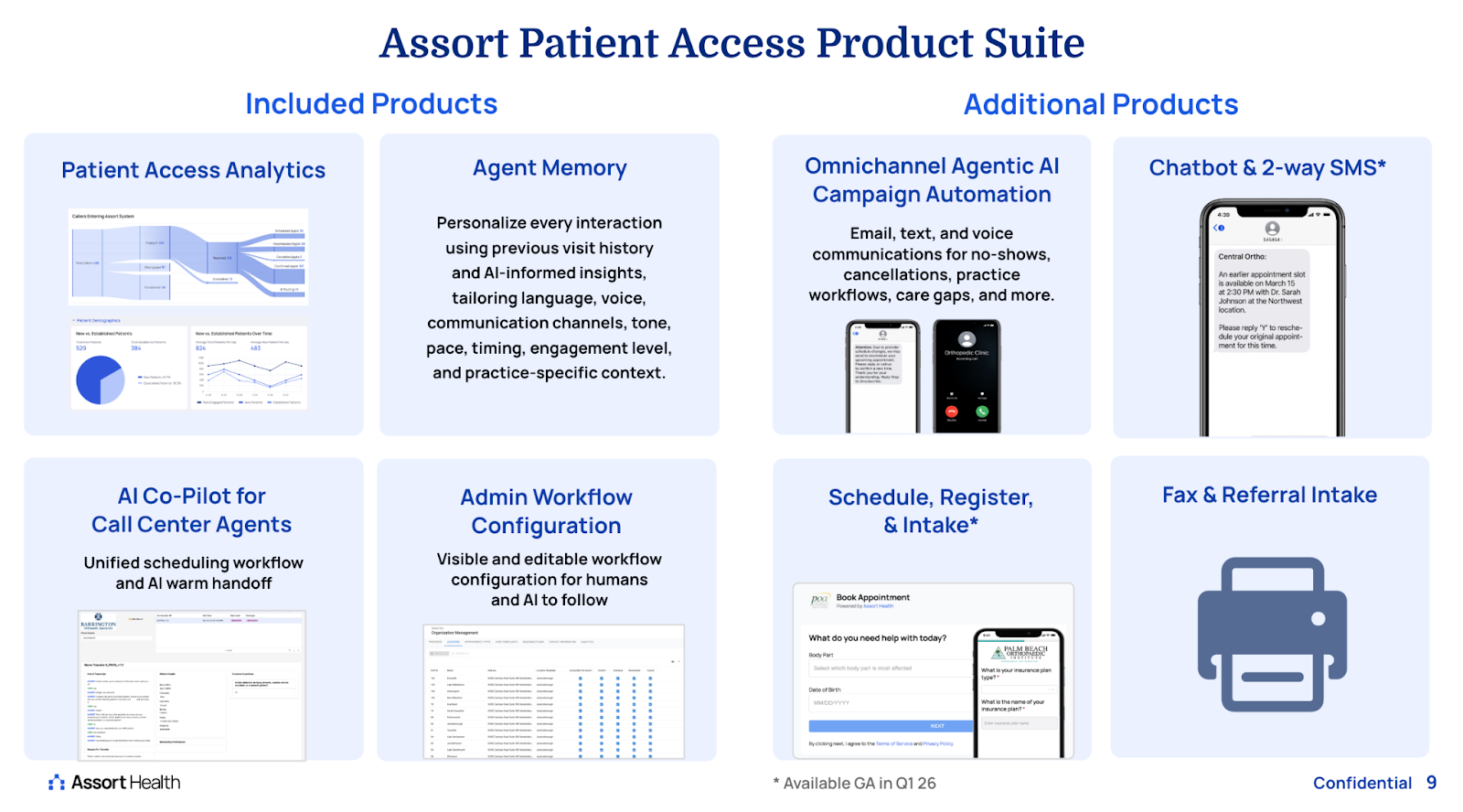
Here’s a few examples of workflows in the real-world:
A patient calls to schedule a new-patient PCP visit. The voice agent verifies identity/insurance, captures reason (“new hypertension patient, home BP ~160/100”), books a 30-min new-patient slot, texts intake and parking info. If there are red-flags (e.g., chest pain, neuro deficits), it warm-handoffs to staff immediately and labels the call “urgent triage.”
Retina detachment risk. The patient calls in and reports “flashes, curtain, new floaters.” It’s not a magic show, your retina might be coming off. The voice agent recognizes urgency, skips the normal queue, alerts the on-call retina team, books within 24–48 hours, and sends do-not-drive guidance. It tags “urgent ophthalmic triage” for the front office staff aka. the eye’s ain’t ballin’.
“Get your flu shot” outbound. A text or phone call from the practice reaches out to patients to remind them that they need to get a flu shot, and within the same conversation can schedule them for the next available appointment.
No-show and cancellation recovery. If a patient no-shows, the agent immediately texts them a 1-click reschedule link. It then offers the freed up slot to waitlisted patients in priority order. The dashboard shows reclaimed hours and fill rate.
Patient collections follow-up. After a visit, the AI agent reaches out to patients with outstanding balances. It confirms preferred payment method, offers to pay securely via link or phone, and answers common billing questions.
Insurance re-verification before visit (outbound). Between 3–5 days pre-appointment, the AI agent pings via text or a phone call. It asks patients to confirm their insurance plan details. If coverage changed, it collects updated info or offers cash-pay options per clinic policy.
What’s The Business Model And Who’s The End User?
Assort charges a B2B SaaS subscription + a price based on minimum call commitments. The end users are mostly front desk staff and practice managers, with patients being users of the system.
When Assort signs a new customer, they use agents to crawl for as much information they can about the provider and integrate with the EHR. They’re trying to figure out:
- What are their current rules around scheduling?
- When they look through old EHR data, what do they learn about their current patient panel/severity/appointment patterns?
- What kinds of payers do they have contracts with and what’re the rules around referrals/pre-auth requirements?
- What type of provider is this, and what are their preferences? No patients when mercury is in retrograde? I guess.
- What type of workflow is this, and what edge cases should we apply by default?
This is ingested by their own set of internal AI agents to customize the existing AI scheduling bot to that specific practice. It takes some humans in the loop and fine-tuning to get there - but eventually the AI bot can handle a big chunk of the scheduling workflows and escalate as needed.

Job Openings
Assort is hiring for a bunch of different roles
Engineering
- Agent Engineer (New Grad, Summer 2026)
- Engineering Manager
- Founding Site Reliability Engineer
- Head of Security
- Senior Agent Software Engineer
- Agent Software Engineer
Executive Operations
Growth
- Account Executive - Health Systems
- Account Executive, Enterprise
- Account Executive, Mid-Market
- Field/Event Marketing Manager
- Head of Business Development / Sales Development
- Head of Sales - Health Systems
- Sales Engineer
- Sales Manager
- Senior Product Marketing Manager / Product Marketing Lead
Operations & Client Success
- Conversational Designer, AI
- Customer Success Manager
- Director of Agent Deployment & Success
- Founding Customer Success Lead
Out-Of-Pocket Take
There’s a few things I like about Assort.
Making the front office experience better. The phone call is one of the patient’s very first touch points with a doctor's office. And it immediately sets the tone of how much of an administrative nightmare this is going to be. Just a month ago I needed to schedule a new appointment and I had to wait on hold for 20 minutes in the middle of the workday! What if I had a real job???
The nice part is that a more flexible, AI-based system should be able to triage tasks so people like me can be handled quickly and asynchronously while the practice staff can spend more of their time on complex patients and helping people in-person.
Expanding practice capabilities. Using these agentic tools actually gives practices the ability to do things they couldn’t do before, which is where AI gets exciting.
- Practice can now take calls after hours and immediately have any language the user prefers to have the conversation in.
- The voice AI agent has a built-in level of clinical expertise in a way front desk and call center staff typically don’t. This allows the voice agent to ask clinically relevant questions and also triage them based on their medical needs.
- The system allows patients to put themselves on a waitlist and get automatically called when a new appointment opens up. Or it can tell patients when a practice is running late proactively, since normally the front desk is time-strapped.
- Mining transcripts of patient calls can help inform the practice and Assort on capabilities they might want to add.
- Detected care gaps can automatically trigger an agent to call out and help you get what you need (e.g. flu shot or cancer screening).
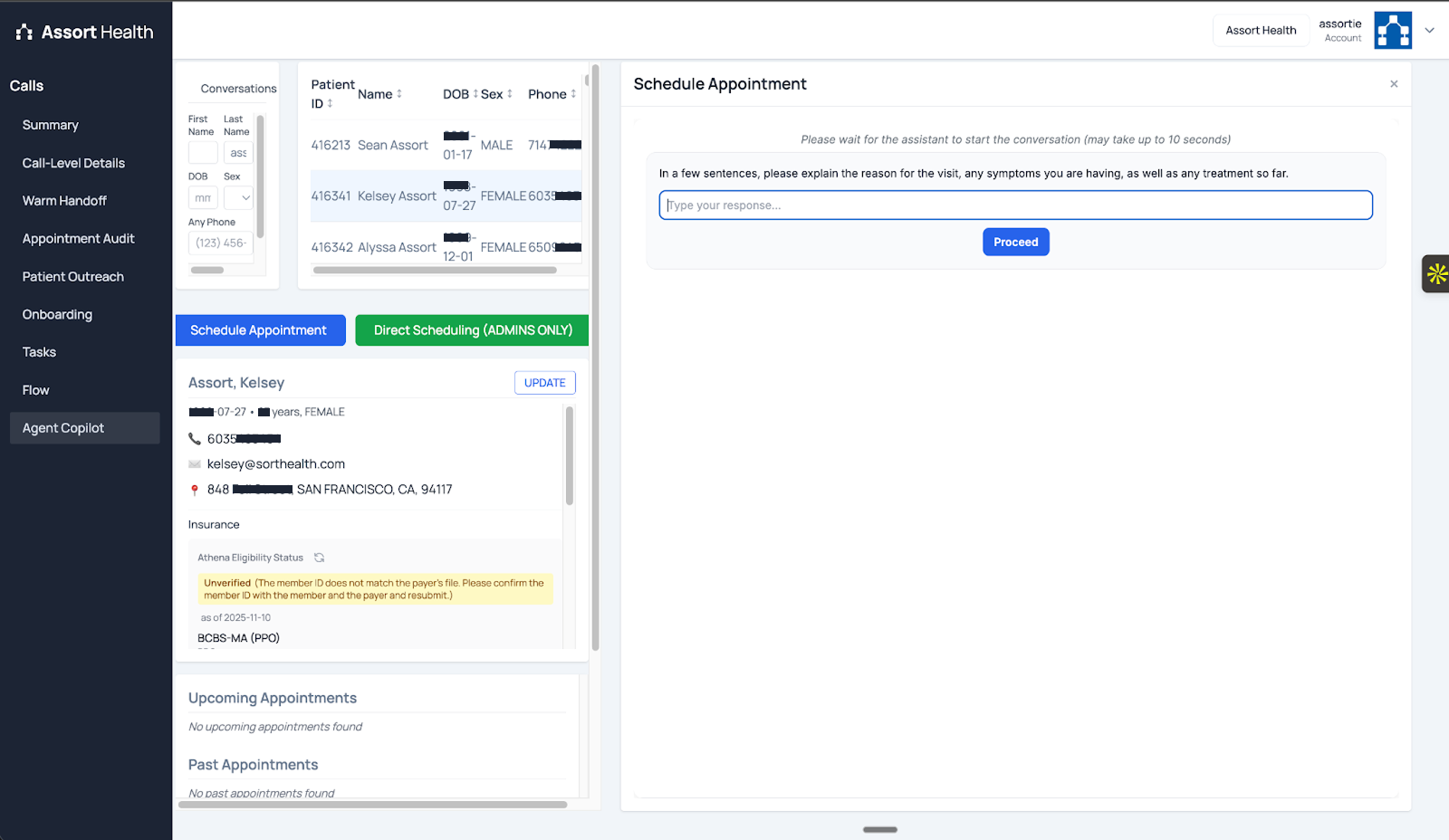
A clean ROI story. Remember when we wrote a two-part series on Return-on-Investment in healthcare because it’s so complicated? Proving the ROI on scheduling is much easier because patients coming in through the door is revenue. In fact, this is why providers focus on an oddly specific metric called Third Next Available Appointment (TNAA). It measures how long it takes for a patient to make a new booked appointment.
In Assort’s case it’s a relatively easy ROI story to tell practices.
- New patients are more likely to complete making a new appointment if it’s easy
- You can fill empty spaces in your schedule more easily, which is normally lost revenue
- You can hire less full-time employees to manage your practice operations
We love an easy financial story to tell. They gave me this case study when I asked for one:
“At OrthoIndy, one of the largest orthopedic groups in the country with around 200 providers, we saw:
131% labor capacity increase (handling 26,425 calls per month)
38% labor cost reduction (automating 17 FTEs worth of work)
1 hour wait times -> 30 second wait times”
–
As with every company, there are things that I think Assort will face as it grows.
Competition - The first and most obvious is competition here. Competition comes from a few different vectors here.
- The systems of records (e.g. EMRs) making their own version of easier scheduling. Scheduling right now still has to happen through the EHR, so there’s a risk they roll out their own tools to make it easier for practices to do that including voice AI.
- Other patient intake and scheduling companies are moving into this space and adding voice + agents as part of their onboarding workflow for new patients.
The question will be around product execution, pricing, and how deep into the full workflow each of these companies chooses to go. There’s probably enough low hanging fruit in this market currently for every player to get traction, but there will likely be a convergence and knife-fight here.
It’s the ever present question - can you build a company around voice AI that wedges into a new product/process? Or is it a feature of existing companies with distribution? Can voice AI answer the voices of doubt in our head???
The brittleness of site-specific workflows - For the last decade there have been companies that have promised helping practice automate workflows, but many of them died because the level of customization each practice needs is high and the automations would break.
As a company gains more customers in different specialties and sizes, the surface area of what can break expands with more custom workflows. The permutations of scheduling workflows become exponentially larger. The rules logic defies actual logic.
Assort’s bet is that these new AI tools will eventually make it easier to understand changes at each site as they happen, adapt, and take rules from customers and apply them to other sites. Today a lot of time is still required to get a practice up and running and the team is still involved in helping the practice adapt to changes. But their bet is the AI is going to improve enough to make orchestration of all these rules easy and require less humans.
Moving to larger hospitals. Large hospitals are very different beasts - their internal workflows are way more complicated, the EHRs are much more competitive with vendors, and scheduling for both inpatient and outpatient is a colossal task.

But the flip side is that it’s possible the scheduling workflows are so complicated that it’s not even feasible for admin staff to handle all of the complexities, and AI agents can actually shine here. If there’s actually a revenue lift from agents and it requires a level of technical/product complexity that incumbent EHRs struggle with, then there might be an opening for a new vendor to come in.
Conclusion and Parting Thoughts
It’s clear that agents are coming to change how the front office of healthcare works. The current experience is frustrating to everyone involved, so we need more companies to be trying different approaches to improve this.
That’s Assort’s goal, and I’m excited to watch as it develops. Remember that if you tell them OOP sent you, they’ll give you $5,000 in credits. You can get some new magazines for the waiting room with that.
Thinkboi out,
Nikhil aka. “Throw that assort in a circle”
Twitter: @nikillinit
IG: @outofpockethealth
Other posts: outofpocket.health/posts
{{sub-form}}
If you’re enjoying the newsletter, do me a solid and shoot this over to a friend or healthcare slack channel and tell them to sign up. The line between unemployment and founder of a startup is traction and whether your parents believe you have a job.
INTERLUDE - FEW COURSES STARTING VERY SOON!!
See All Courses →A reminder that there’s a few courses STARTING VERY SOON!!
LLMs in healthcare (starts 9/8) - We break down the basics of Large Language Models like chatGPT, talk about what they can and can’t do in healthcare, and go through some real-world examples + prototyping exercises.
Healthcare 101 (starts 9/22) - I’ll teach you and your team how healthcare works. How everyone makes money, the big laws to know, trends affecting payers/pharma/etc.
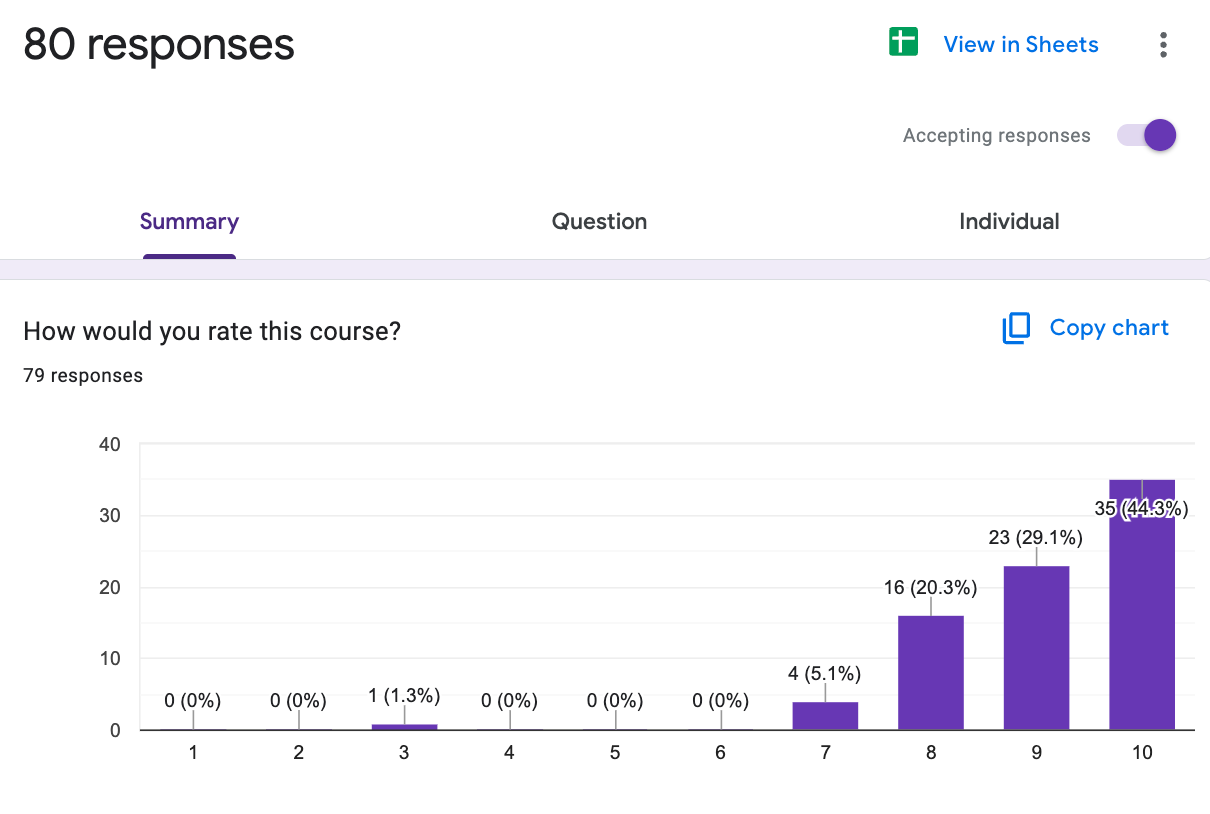
We’ll do group rates, custom workshops, etc. - email sales@outofpocket.health and we’ll send you details.
INTERLUDE - FEW COURSES STARTING VERY SOON!!
See All Courses →A reminder that there’s a few courses STARTING VERY SOON!! And it’s the final run for all of them (except healthcare 101).
LLMs in healthcare (starts 9/8) - We break down the basics of Large Language Models like chatGPT, talk about what they can and can’t do in healthcare, and go through some real-world examples + prototyping exercises.
Healthcare 101 (starts 9/22) - I’ll teach you and your team how healthcare works. How everyone makes money, the big laws to know, trends affecting payers/pharma/etc.
How to contract with Payers (starts 9/22) - We’ll teach you how to get in-network with payers, how to negotiate your rates, figure out your market, etc.
We’ll do group rates, custom workshops, etc. - email sales@outofpocket.health and we’ll send you details.
INTERLUDE - FEW COURSES STARTING VERY SOON!!
See All Courses →A reminder that there’s a few courses STARTING VERY SOON!! And it’s the final run for all of them (except healthcare 101).
LLMs in healthcare (starts 9/8) - We break down the basics of Large Language Models like chatGPT, talk about what they can and can’t do in healthcare, and go through some real-world examples + prototyping exercises.
Healthcare 101 (starts 9/22) - I’ll teach you and your team how healthcare works. How everyone makes money, the big laws to know, trends affecting payers/pharma/etc.
How to contract with Payers (starts 9/22) - We’ll teach you how to get in-network with payers, how to negotiate your rates, figure out your market, etc.
Selling to Health Systems (starts 10/6) - Hopefully this post explained the perils of selling point solutions to hospitals. We’ll teach you how to sell to hospitals the right way.
EHR Data 101 (starts 10/14) - Hands on, practical introduction to working with data from electronic health record (EHR) systems, analyzing it, speaking caringly to it, etc.
We’ll do group rates, custom workshops, etc. - email sales@outofpocket.health and we’ll send you details.
INTERLUDE - FEW COURSES STARTING VERY SOON!!
See All Courses →A reminder that there’s a few courses STARTING VERY SOON!! And it’s the final run for all of them (except healthcare 101).
LLMs in healthcare (starts 9/8) - We break down the basics of Large Language Models like chatGPT, talk about what they can and can’t do in healthcare, and go through some real-world examples + prototyping exercises.
Healthcare 101 (starts 9/22) - I’ll teach you and your team how healthcare works. How everyone makes money, the big laws to know, trends affecting payers/pharma/etc.
How to contract with Payers (starts 9/22) - We’ll teach you how to get in-network with payers, how to negotiate your rates, figure out your market, etc.
Selling to Health Systems (starts 10/6) - Hopefully this post explained the perils of selling point solutions to hospitals. We’ll teach you how to sell to hospitals the right way.
EHR Data 101 (starts 10/14) - Hands on, practical introduction to working with data from electronic health record (EHR) systems, analyzing it, speaking caringly to it, etc.
We’ll do group rates, custom workshops, etc. - email sales@outofpocket.health and we’ll send you details.
Interlude - Our 3 Events + LLMs in healthcare
See All Courses →We have 3 events this fall.
Data Camp sponsorships are already sold out! We have room for a handful of sponsors for our B2B Hackathon & for our OPS Conference both of which already have a full house of attendees.
If you want to connect with a packed, engaged healthcare audience, email sales@outofpocket.health for more details.





